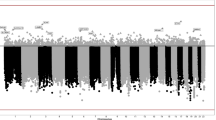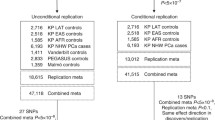Abstract
There is considerable evidence that genetic factors are involved in prostate cancer susceptibility. We have studied the association of 11 single nucleotide polymorphisms (SNPs) in the HEPSIN gene (HPN) with prostate cancer in men of European ancestry. HPN is a likely candidate in prostate cancer susceptibility, as it encodes a transmembrane cell surface serum protease, which is overexpressed in prostate cancer; HPN is also located on 19q11–q13.2, where linkage is found with prostate cancer susceptibility. In this case-control association study (590 men with histologically verified prostate cancer and 576 unrelated controls, all of European descent), we find significant allele frequency differences between cases and controls at five SNPs that are located contiguously within the gene. A major 11-locus haplotype is significantly associated, which provides further support that HPN is a potentially important candidate gene involved in prostate cancer susceptibility. Association of one of the SNPs with Gleason score is also suggestive of a plausible role of HPN in tumor aggressiveness.


Similar content being viewed by others
References
Albertsen PC, Hanley JA, Fine J (2005) 20-year outcomes following conservative management of clinically localized prostate cancer. JAMA 293:2095–2101
Baker SG, Lichtenstein P, Kaprio J, Holm N (2005) Genetic susceptibility to prostate, breast and colorectal cancer among Nordic twins. Biometrics 61:55–63
Boehnke M (1991) Allele frequency estimation from data on relatives. Am J Hum Genet 48:22–25
Burmester JK, Suarez BK, Lin JH, Jin CH, Miller RD, Zhang KQ, Salzman SA, Reding DJ, Catalona WJ (2004) Analysis of candidate genes for prostate cancer. Hum Hered 57:172–178
Chen Z, Fan Z, McNeal JE, Nolley R, Caldwell MC, Mahadevappa M, Zhang Z, Warrington JA, Stamey TA (2003) Hepsin and maspin are inversely expressed in laser capture microdissectioned prostate cancer. J Urol 169:1316–1319
Dhanasekaran SM, Barrette TR, Ghosh D, Shah D, Varambally S, Kurachi K, Pienta KJ, Rubin MA, Chinnaiyan AM (2001) Delineation of prognostic biomarkers in prostate cancer. Nature 412:822–826
Dietmaier W, Hartmann A, Wallinger S, Heinmöller E, Kerner T, Endl E, Jauch K-W, Hofstädter F, Rüschoff J (1999) Multiple mutation analyses in single tumor cells with improved whole genome amplification. Am J Path 154:83–95
Goddard KA, Witte JS, Suarez BK, Catalona WJ, Olson JM (2001) Model-free linkage analysis with covariates confirms linkage of prostate cancer to chromosomes 1 and 4. Am J Hum Genet 68:1197–1206
Jemal A, Siegel R, Ward E, Murray T, Xu J, Smigal C, Thun MJ (2006) Cancer Statistics 2006. CA Cancer J Clin 56:106–130
Jiang Z, Zhang X, Deka R, Jin L (2005) Genome amplification of single sperm using multiple displacement amplification. Nucleic Acids Res 33:e91
Khoury MJ, Beaty TH, Cohen BH (1993) Fundamentals of genetic epidemiology. Oxford University Press, New York
Lange K, Weeks D, Boehnke M (1988) Programs for pedigree analysis: MENDEL, FISHER and dGENE. Genet Epidemiol 5:471–472
Lichtenstein P, Holm NV, Verkasalo PK, Iliadou A, Kaprio J, Koskenvuo M, Pukkala E, Skytthe A, Hemminki K (2000) Environmental and heritable factors in the causation of cancer—analyses of cohorts of twins from Sweden, Denmark, and Finland. N Engl J Med 343:78–85
Magee JA, Araki T, Patil S, Ehrig T, True L, Humphrey PA, Catalona WJ, Watson MA, Milbrandt J (2001) Expression profiling reveals hepsin overexpression in prostate cancer. Cancer Res 61:5692–5696
Neville PJ, Conti DV, Krumroy LM, Catalona WJ, Suarez BK, Witte JS, Casey G (2003) Prostate cancer aggressiveness locus on chromosome segment 19q12–q13.1 identified by linkage and allelic imbalance studies. Genes Chromosomes Cancer 36:332–339
Rhodes DR, Barrette TR, Rubin MA, Ghosh D, Chinnaiyan AM (2002) Meta-analysis of microarrays: interstudy validation of gene expression profiles reveals pathway dysregulation in prostate cancer. Cancer Res 62:4427–4433
Simard J, Dumont M, Soucy P, Labrie F (2002) Perspective: prostate cancer susceptibility genes. Endocrinology 143:2029–2040
Smith DS, Humphrey PA, Catalona WJ (1997) The early detection of prostate carcinoma with prostate specific antigen: the Washington university experience. Cancer 80:1852–1856
Stamey TA, Warrington JA, Caldwell MC, Chen Z, Fan Z, Mahadevappa M, McNeal JE, Nolley R, Zhang Z (2001) Molecular genetic profiling of Gleason grade 4/5 prostate cancers compared to benign prostatic hyperplasia. J Urol 166:2171-2177
Stephan C, Yousef GM, Scorilas A, Jung K, Jung M, Kristiansen G, Hauptmann S, Kishi T, Nakamura T, Loening SA, Diamandis EP (2004) Hepsin is highly over expressed in and a new candidate for a prognostic indicator in prostate cancer. J Urol 171:187–191
Stephens M, Smith NJ, Donnelly P (2001) A new statistical method for haplotype reconstruction from population data. Am J Hum Genet 68:978–989
Suarez BK, Lin J, Burmester JK, Broman KW, Weber JL, Banerjee TK, Goddard KA, Witte JS, Elston RC, Catalona WJ (2000a) A genome screen of multiplex sibships with prostate cancer. Am J Hum Genet 66:933–944
Suarez BK, Lin J, Witte JS, Conti DV, Resnick MI, Klein EA, Burmester JK, Vaske DA, Banerjee TK, Catalona WJ (2000b) Replication linkage study for prostate cancer susceptibility genes. Prostate 45:106–114
Suarez BK, Pal P, Jin CH, Kaushal R, Sun G, Jin L, Pasche B, Deka R, Catalona WJ (2005) TGFBR1*6A is not associated with prostate cancer in men of European ancestry. Prostate Cancer Prostatic Dis 8:50–53
Sun G, Kaushal R, Pal P, Wolujewicz M, Smelser D, Cheng H, Lu M, Chakraborty R, Jin L, Deka R (2005) Whole-genome amplification: relative efficiencies of the current methods. Legal Med 7:279–286
Westfall PH, Young SS (1993) Resampling-based multiple testing: examples and methods for p-value adjustments. Wiley, New York
Witte JS, Goddard KA, Conti DV, Elston RC, Lin J, Suarez BK, Broman KW, Burmester JK, Weber JL, Catalona WJ (2000) Genomewide scan for prostate cancer-aggressiveness loci. Am J Hum Genet 67:92–99
Witte JS, Suarez BK, Thiel B, Lin J, Yu A, Banerjee TK, Burmester JK, Caey G, Catalona WJ (2003) Genome-wide scan of brothers: replication and fine mapping of prostate cancer susceptibility and aggressiveness loci. Prostate 57:298–308
Xu J, Stolk JA, Zhang X, Silva SJ, Houghton RL, Matsumara M, Vedvick TS, Leslie KB, Badaro R, Reed SG (2000) Identification of differentially expressed genes in human prostate cancer using subtraction and microarray. Cancer Res 60:1677–1682
Xu J, Dimitrov L, Chang BL, Adams TS, Turner AR, Meyers DA, Eeles RA, Easton DF, Foulkes WD, Simard J, Giles GG, Hopper JL, Mahle L, Moller P, Bishop T, Evans C, Edwards S, Meitz J, Bullock S, Hope Q, Hsieh CL, Halpern J, Balise RN, Oakley-Girvan I, Whittemore AS, Ewing CM, Gielzak M, Isaacs SD, Walsh PC, Wiley KE, Isaacs WB, Thibodeau SN, McDonnell SK, Cunningham JM, Zarfas KE, Hebbring S, Schaid DJ, Friedrichsen DM, Deutsch K, Kolb S, Badzioch M, Jarvik GP, Janer M, Hood L, Ostrander FA, Stanford JL, Lange FM, Beebe-Dimmer JL, Mohai CE, Cooney KA, Ikonen T, Baffoe-Bonnie A, Fredriksson H, Matikainen MP, Tammela TLJ, Bailey-Wilson J, Schleufler J, Maier C, Herkommer K, Hoegel JJ, Vogel W, Paiss T, Wiklund F, Emanuelsson M, Stenman E, Jonsson BA, Gronberg H, Camp NJ, Farnham J, Cannon-Albright LA, Seminara D (2005) A combined genomewide linkage scan of 1,233 families for prostate cancer-susceptibility genes conducted by the international consortium for prostate cancer genetics. Am J Hum Genet 77:219–229
Zaykin DV, Westfall PH, Young SS, Karnoub MC, Wagner MJ, Ehm MG (2002) Testing association of statistically inferred haplotypes with discrete and continuous traits in samples of unrelated individuals. Hum Hered 53:79–91
Acknowledgments
This study was supported by a grant from the Urological Research Foundation.
Author information
Authors and Affiliations
Corresponding author
Rights and permissions
About this article
Cite this article
Pal, P., Xi, H., Kaushal, R. et al. Variants in the HEPSIN gene are associated with prostate cancer in men of European origin. Hum Genet 120, 187–192 (2006). https://doi.org/10.1007/s00439-006-0204-3
Received:
Accepted:
Published:
Issue Date:
DOI: https://doi.org/10.1007/s00439-006-0204-3




